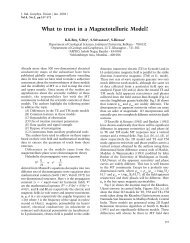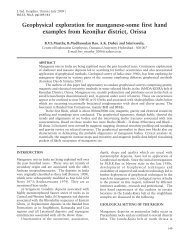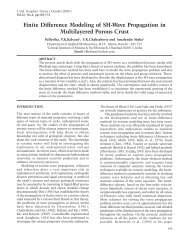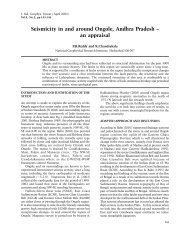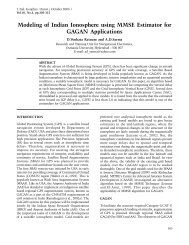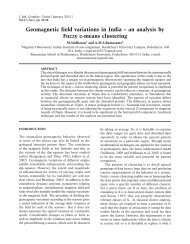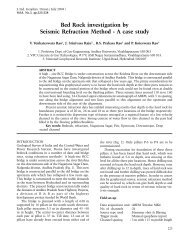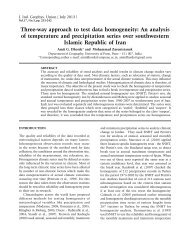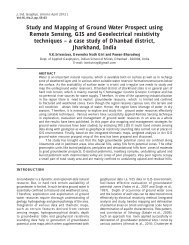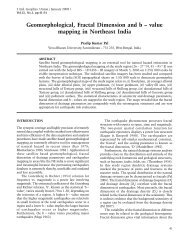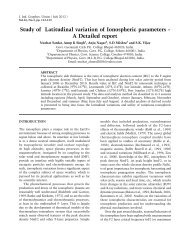U.S. De**, G. P. Singh* and D. M. Rase - IGU
U.S. De**, G. P. Singh* and D. M. Rase - IGU
U.S. De**, G. P. Singh* and D. M. Rase - IGU
You also want an ePaper? Increase the reach of your titles
YUMPU automatically turns print PDFs into web optimized ePapers that Google loves.
J. Ind. Geophys. Union ( April 2013 )<br />
Vol.17, No.2, pp. 153-165<br />
Urban flooding in recent decades in<br />
four mega cities of India<br />
U.S. <strong>De**</strong>, G. P. <strong>Singh*</strong> <strong>and</strong> D. M. <strong>Rase</strong>*<br />
**Visiting faculty Department of Environment Science/ V.S.I. Pune, India <strong>and</strong><br />
Former Additional Director General of Meteorology (Research), Pune<br />
*India Meteorological Department, Pune – 411005<br />
E-mail: gauravendra.singh@gmail.com<br />
ABSTRACT<br />
Floods, extreme weather events, have occurred with frequent regularity over last two decades<br />
causing severe urban flood related inundations. In the present scenario, rapidly exp<strong>and</strong>ing mega<br />
cities (due to migration of people from rural India) are facing many problems. The four mega<br />
cities: Delhi, Kolkata, Mumbai <strong>and</strong> Chennai are the most populated cities of India. Uncontrolled<br />
growth of mega cities has increased their vulnerability to flooding. For a better underst<strong>and</strong>ing<br />
of the problem, extreme rainfall events have been analysed for the period 1970-2006 for two<br />
stations each in the four Mega Cities. Their spatial variation, frequency <strong>and</strong> trends have been<br />
computed <strong>and</strong> discussed.<br />
In this study, analysis has been made about the casualties due to floods in these cities from<br />
the period 1988 to 2007. Data from Disastrous Weather Events published by India Meteorological<br />
Department have been used. The study brings out the impact of urban flooding, leading to human<br />
deaths, for each city taking in to context the different geographical <strong>and</strong> climatic aspects. Some<br />
measures are suggested to minimize the losses from such natural hazards.<br />
INTRODUCTION<br />
Floods are the natural hazards caused directly by<br />
weather events like heavy rains over inl<strong>and</strong> area<br />
<strong>and</strong> cyclones in the coastal belt. They often become<br />
disastrous, due to human activities that interfere<br />
with natural ecology.<br />
During the last two decades there has been a<br />
major shift of population in urban areas, especially in<br />
major metro cities of India. By 2025, the population<br />
of tropical Asia is projected to rise to 2.4 billion.<br />
Significant number of the world’s most populated<br />
cities are located in Asia viz., Tokyo, Mumbai,<br />
Shanghai, Kolkata, Jakarta, Delhi, Seoul, Manila<br />
<strong>and</strong> Dhaka. Three of these are located in India.<br />
This demographic explosion enhances further the<br />
vulnerability of these urban conglomerations to floods<br />
<strong>and</strong> flash floods. Since the ecological intervention is<br />
minimal due to lesser population in United States,<br />
which is a developed nation (even though floods<br />
cause about $ 6 billion worth of damage) the human<br />
loss is limited to about 100-150 people every year.<br />
In contrast in China’s yellow river valley (a densely<br />
populated region), where some of the world’s worst<br />
floods have occurred, millions of people have perished<br />
in floods during the last century. During the past<br />
25 years, there have been over three million deaths,<br />
of which 90 percent were in developing countries<br />
(Bedritsky, 1999).<br />
Several authors have studied increase in frequency<br />
of very heavy rainfall <strong>and</strong> impact of urbanization<br />
on meteorological variables (Guhathakurta et al,<br />
2011, Ghosh et al, 2009, Goswami et al 2006,<br />
De <strong>and</strong> Rao, 2004, Khole <strong>and</strong> De 2001, De et al<br />
2005, Rao et al, 2004, Sinha Ray et al, 1999). Some<br />
of the growing urban mega cities such as Delhi,<br />
Mumbai, Kolkata <strong>and</strong> Chennai are likely to undergo<br />
severe resource stress in coming decades due to<br />
rising population. Residents of flooded cities face<br />
another type of disaster where unavailability of clean<br />
water <strong>and</strong> improper sanitization facilities after <strong>and</strong><br />
during flood lead to outbreaks of deadly waterborne<br />
diseases like typhoid, hepatitis A <strong>and</strong> cholera.<br />
Rapid industrialization <strong>and</strong> urbanization has led to<br />
concentration of the population around the exp<strong>and</strong>ing<br />
fringes of the mega cities. Due to improper planning<br />
of growing mega cities there is a very low capacity of<br />
such societies to absorb climatic shocks. The present
U.S. De, G. P. Singh <strong>and</strong> D. M. <strong>Rase</strong><br />
study analyses the last twenty years data pertaining<br />
to major floods in four metro cities of India, which<br />
have a population exceeding 5 million.<br />
DATA AND METHODOLOGY<br />
The first census of India during the 20 th century<br />
showed that only one city had a population more<br />
than one million. In 1991 census, 14 cities with<br />
population more than one million existed while<br />
the census of 2001 shows, 22 such cities. The four<br />
mega cities, which are under study, are located in<br />
the four quadrants of India, North - Delhi, East<br />
- Kolkata, West - Mumbai, <strong>and</strong> South - Chennai.<br />
Their population <strong>and</strong> population growth are taken as<br />
reported in Govt. of India census of 1991 <strong>and</strong> 2001<br />
(Table- 1). The major disasters caused due to floods in<br />
the four mega cities as reported in Disastrous Weather<br />
Events (DWE), (India Meteorological Department) are<br />
used in this study. In order to study urban flooding<br />
daily rainfall data for two observatories in each of the<br />
mega cities are used (1970-2006). For each mega city<br />
one observatory in the city <strong>and</strong> one in the airport<br />
are taken so that its spatial distribution of rainfall<br />
can be better analyzed. The stations are Colaba <strong>and</strong><br />
Santacruz Airport in Mumbai, Nungambakkam<br />
<strong>and</strong> Minambakkam Airport in Chennai, Alipur <strong>and</strong><br />
Dumdum Airport in Kolkata <strong>and</strong> Safdarjung <strong>and</strong><br />
Palam Airport in Delhi. Daily rainfall data for the<br />
period 1970-2006 have been utilized to study very<br />
heavy rainfall (≥125 mm) <strong>and</strong> phenomenal rainfall<br />
(≥150 mm) <strong>and</strong> their trends.<br />
FLOODS/HEAVY RAINS<br />
Floods occur in almost all the river basins of the<br />
country. A flood is an overflow of an expanse of water<br />
that submerges l<strong>and</strong>. Every year floods affect nearly<br />
400 million hectares of l<strong>and</strong> in India (Sinha Ray et<br />
al, 1999). Seasonal peak in mortality occurs during<br />
rainy season in the tropical belt. Specific cases of<br />
floods in the four metros of India are discussed in<br />
the next section.<br />
Urban Floods<br />
India is primarily an agricultural country. In the<br />
past, rural infra structure was adequate to sustain<br />
population of country. Migration of population<br />
towards mega cities has resulted in r<strong>and</strong>om expansion<br />
of urban sector. Such migrations are due to industrial<br />
growth. Presently some of the urban agglomerations<br />
accommodate more than 10 million people. According<br />
to a recent estimate, by 2015 India will have 34 cities<br />
in the population range of 1.5 million <strong>and</strong> above.<br />
Four mega Cities selected for the present study would<br />
have crossed 10 million mark, in which Mumbai<br />
would have the largest population density of more<br />
than 27 million. Majority of the poor live in informal<br />
settlements. In future these settlements would<br />
grow in a r<strong>and</strong>om way due to inadequacy of space<br />
<strong>and</strong> resources. Thous<strong>and</strong>s of illegal colonies have<br />
emerged in the mega cities resulting in constriction<br />
of natural drainage causing urban floods. Urban<br />
areas get flooding by different types of floods like<br />
river floods, flash floods, coastal floods, release of<br />
excess water from reservoir or failure of dam on the<br />
upstream side etc. Heavy rainfall is the main cause<br />
of urban flood. Due to intense <strong>and</strong> periodic rain,<br />
huge quantity of water flows, beyond the capacity<br />
of old drainage systems of the mega cities. Drainage<br />
system gets blocked due to silting, dumping of waste<br />
material at the inlets of drainage, encroachment over<br />
natural drainage <strong>and</strong> water bodies.<br />
Significant Urban Floods in India in recent years<br />
The Year 2005 was recorded as the hottest year of<br />
the century. Incidentally, in the same year the worst<br />
urban flooding was reported in Mumbai on 26/27 July,<br />
with the historical rainfall of 944 mm. In this year 10<br />
severe urban floodings, were also reported, in which<br />
Table 1. Population of four mega cities in India (MILLIONS)<br />
Megacities Census 1991(million) Census 2001 (million) Estimate growth(%)<br />
Mumbai 12.6 17.7 4.05%<br />
Kolkata 11.0 14.7 3.36%<br />
Delhi 8.4 13.8 6.43%<br />
Chennai 5.4 8.2 5.18%<br />
154
Urban flooding in recent decades in four mega cities of India<br />
Chennai flooding was remarkable. It affected more<br />
than 5, 00,000 people. Three fourths of Chennai<br />
was inundated. Next year i.e. 2006, number of urban<br />
floodings were reported in 22 cities. The increasing<br />
trend of flooding was carried into 2007 also, where<br />
number of affected cities rose to 35 in which Kolkata<br />
was the worst affected. In the year 2008, severe urban<br />
floodings were reported, Mumbai was the worst<br />
affected. In the year 2010, Mumbai (Colaba) received<br />
130 mm <strong>and</strong> 210 mm rainfall on 19 th <strong>and</strong> 25 th June.<br />
On 4 th July, it received 149 mm rainfall. Santacruz<br />
received 158 mm <strong>and</strong> 138 mm rainfall on 17 th <strong>and</strong><br />
30 th August. A summary of casualties due to floods<br />
/heavy rains is shown in Table - 2.<br />
It is observed from the table that maximum<br />
number of deaths have occurred in Mumbai. Amongst<br />
all the four cities Delhi reported lowest deaths. In<br />
Delhi (capital of the country), an inl<strong>and</strong> city, proper<br />
planning <strong>and</strong> preventive measures have been taken,<br />
resulting in minimum number of causalities.<br />
Impact of flooding on mega cities<br />
The direct <strong>and</strong> secondary effects of major floods in<br />
these selected 4 mega cities are briefly described<br />
below:<br />
Delhi<br />
Delhi, capital of the country with an area of 1483<br />
km 2 has an estimated population of 13.8 million.<br />
The average annual rainfall of Delhi is 670 mm,<br />
most of which falls during SW monsoon, in July <strong>and</strong><br />
August. The flood season observed by Delhi govt. is<br />
Table 2. Number of Deaths/Injured in four mega cities<br />
Year Delhi Kolkata Mumbai Chennai<br />
Deaths Injured Deaths Injured Deaths Injured Deaths Injured<br />
1988 - - 2 2 26 19 3 4<br />
1989 - - - - - - -<br />
1990 3 5 1 19 79 66 15 -<br />
1991 5 - - 2 78 100 21 6<br />
1992 1 - - 15 19 2 - -<br />
1993 3 3 14 15 40 61 - -<br />
1994 - - - - 27 46 3 2<br />
1995 2 - 6 22 7 - 12 -<br />
1996 10 - 3 5 27 14 -<br />
1997 2 1 - - 25 59 -<br />
1998 - - - 8 - - -<br />
1999 - - - 24 6 - -<br />
2000 - - - 87 65 6 -<br />
2001 - - - - 18 - - -<br />
2002 2 - - - 10 - - -<br />
2003 7 6 - - 6 2 - -<br />
2004 - - 35 4 36 51 2 -<br />
2005 - - 16 4 1000 3 13 -<br />
2006 - - - - 182 18 47 -<br />
2007 - - 34 - 57 3 8 -<br />
155
U.S. De, G. P. Singh <strong>and</strong> D. M. <strong>Rase</strong><br />
from July to October. In recent times this city has<br />
attracted millions of people from neighboring states<br />
like Haryana, Punjab, Uttar Pradesh, Rajasthan<br />
<strong>and</strong> Bihar. Delhi can be divided into three major<br />
geographical regions: the Yamuna flood plain, the<br />
ridge, <strong>and</strong> the Gangetic plains. The average elevation<br />
of Delhi from mean sea level is 233 m, where as<br />
from ridge area to Yamuna flood plain, it varies from<br />
305 m to 213 m. Heavy rains in the past, over Delhi<br />
high l<strong>and</strong> ridge area have not affected the city due<br />
to natural drainage system for rain water to flow to<br />
the Yamuna river. Most populated parts of Delhi are<br />
inside the Yamuna flood plains. In the recent past<br />
thous<strong>and</strong>s of illegal colonies have emerged in this<br />
part as well as in Delhi. Many unauthorized colonies<br />
have been developed on agricultural l<strong>and</strong> by local<br />
colonizers without considering city plans, drainage,<br />
<strong>and</strong> sewerage etc. Number of surface water bodies has<br />
been reduced from 800 to 600 due to encroachment.<br />
Capital has suffered floods in 1924, 1947, 1967,<br />
1971, 1975, 1976, 1978, 1980, 1993, 1995 <strong>and</strong> 1998.<br />
In Delhi 5 persons were killed <strong>and</strong> normal life was<br />
completely paralyzed due to heavy rains on 25-26<br />
August 1991. During floods in 1993, 206 localities<br />
were inundated <strong>and</strong> traffic was disturbed in 130<br />
stretches. Flooding resulted in the damage of roads<br />
<strong>and</strong> collapsing of bridges, causing traffic congestion.<br />
In the month of September (24-26), 2010 a flash<br />
flood in Uttarakh<strong>and</strong> has raised the water level in<br />
Yamuna above danger mark, which did not recede for<br />
several days. The ground water table in the low lying<br />
areas rose so high that one of the buildings collapsed<br />
leading to death of 70 people. In many colonies water<br />
was in the basement of the buildings. This indicates<br />
that such collapsing of buildings may happen in<br />
future also. In 1995-1996, 21300 people developed<br />
jaundice after drinking contaminated water, De <strong>and</strong><br />
Ray (2000). There was outbreak of malaria, dengue,<br />
<strong>and</strong> other diseases after every flood.<br />
Kolkata<br />
As per 2001 census Kolkata metropolitan area is<br />
1851.41km 2 with a population of 14.72 million.<br />
It is one of the most densely populated cities of<br />
India. Kolkata Municipal Corporation (KMC) is even<br />
more densely populated as its population density is<br />
24,429 persons per km 2 . Floating population is about<br />
60,00,000 in KMC. Much of the city was originally a<br />
vast wet l<strong>and</strong>, reclaimed over decades to accommodate<br />
the city population. Its elevation from mean sea level<br />
is from 1.5 m to 9 m. Average annual rainfall is 1500<br />
mm. Floods in Kolkata are due to heavy rains in<br />
monsoon or because of tropical cyclones. In summer<br />
many of the depressions, which form in the head<br />
Bay of Bengal <strong>and</strong> move along monsoon trough, yield<br />
maximum rainfall in <strong>and</strong> around Kolkata region.<br />
Because of very flat flood plains of south Bengal delta,<br />
floods are a major concern for these areas. There are<br />
many non-permanent housing structures in Kolkata,<br />
which are subjected to heavy damage during floods.<br />
Slum dwellers constitute approximately 40 per cent<br />
of the population. On 4 th may 2005, heavy rains<br />
killed 11 people in Kolkata <strong>and</strong> in the same year,<br />
on 21 st October, 7 lakh people were affected due to<br />
heavy rains. In September (2 nd <strong>and</strong> 3 rd week) 2004, 17<br />
persons died <strong>and</strong> 2700 houses were damaged. Kolkata<br />
was affected by severe floods during 22-26 Sept. 1999.<br />
On 27 May 2009, Cyclone Aila has crossed the West<br />
Bengal coast. At least 18 of the 45 fatalities in West<br />
Bengal were in Kolkata.<br />
Mumbai<br />
Mumbai is the financial capital of India. Its area is<br />
about 600 km 2 with a population of 17.7 million<br />
(2001). City is built by merging of 7 isl<strong>and</strong>s <strong>and</strong><br />
hilly areas. Most parts of the city are developed with<br />
massive reclamation. Because of limited l<strong>and</strong> area<br />
the population density of the city is growing rapidly.<br />
Mumbai is not only the most populated city in India,<br />
but also the sixth most populated city in the world. It<br />
is among the few port cities of the world where influx<br />
of work force for major industrial <strong>and</strong> economic<br />
activities has resulted in increase of total population<br />
from 12.6 million in 1991 to 17.7 million in 2001.<br />
Over 60 per cent of population resides in poorly built<br />
temporary settlements. South West monsoon lashes<br />
the city with rains between June to September. Some<br />
of the semi permanent synoptic systems like the “Off<br />
shore trough”, “Off shore vortex”, “Mid tropospheric<br />
cyclone” are responsible for heavy to very heavy rain<br />
fall in this city. Normal annual rainfall of Mumbai is<br />
2422 mm. Floods in Mumbai are a common feature<br />
during the monsoon season. The existing storm<br />
drainage system in Mumbai was put in place in early<br />
20 th century. Only 3 outfalls to the sea have flood<br />
gates <strong>and</strong> rest of the 102 outfalls open directly into<br />
the sea. During high tide the sea water rushes into<br />
the drainage system causing more flooding.<br />
156
Urban flooding in recent decades in four mega cities of India<br />
A heavy rain in Mumbai leads to street flooding,<br />
disruption of traffic <strong>and</strong> telecommunication lines.<br />
City is paralyzed <strong>and</strong> thous<strong>and</strong>s of working hours are<br />
lost causing economic loss, when railway tracks are<br />
submerged under water. Slums <strong>and</strong> hutments on the<br />
slopes of hills in suburban Mumbai face l<strong>and</strong>slides,<br />
causing heavy causalities. Many people are killed<br />
when old buildings collapse in heavy rains. The<br />
unprecedented rains of 26-27 July, 2005 have drawn<br />
global attention.<br />
This city has witnessed the historic rainfall of 944<br />
mm in 24 hours, which is one of the eight heaviest<br />
rainfalls ever recorded (De et al, 2006). For the first<br />
time domestic <strong>and</strong> international airports were shut<br />
down for 30 hours during the period due to heavy<br />
flooding <strong>and</strong> poor visibility. Again on 31 th July more<br />
than 700 flights were cancelled or delayed with the<br />
increase of water logging of runways. Rail links were<br />
disrupted <strong>and</strong> long distance trains were cancelled<br />
till 6 th of August. Nearly 1000 human deaths were<br />
reported <strong>and</strong> estimated loss in terms of industry<br />
<strong>and</strong> commerce was about US $ 10 million. During<br />
5-7 August, 2005, 8 persons died <strong>and</strong> many got<br />
injured due to l<strong>and</strong>slide in Kurla. On 8 th July 2000,<br />
5 people died in building collapse <strong>and</strong> on 21 st July,<br />
65 people died <strong>and</strong> 50 got injured due to l<strong>and</strong>slide<br />
in Ghatkopar area. Heavy rains on 7-10 June 1991<br />
in Mumbai <strong>and</strong> Thane have taken 74 lives <strong>and</strong><br />
injured100 people. A study by Tongdi Jamir et al,<br />
(2008) over west coast reveals that meteorological<br />
conditions <strong>and</strong> physiography of the study area<br />
make them vulnerable to floods during the summer<br />
monsoon season. In Mumbai, every year epidemics<br />
are reported during SW Monsoon season, where<br />
flooding mixes the sewerage with fresh water supply<br />
causing waterborne diseases like jaundice, cholera,<br />
hepatitis A etc. Thous<strong>and</strong>s of cases of water borne<br />
diseases are reported every year.<br />
Chennai<br />
Chennai is located on the southern part of eastern<br />
coast of India. It is state capital of Tamilnadu with<br />
a population of 8.2 million. It is the fourth most<br />
populated city of India. Chennai is in northeastern<br />
part of Tamilnadu on a flat coastal plain with<br />
an average elevation of around 6.7 meters. Two<br />
rivers me<strong>and</strong>er through the city, the Cooum River<br />
<strong>and</strong> Adyar River. Several lakes of varying sizes<br />
are located on the western fringes of the city.<br />
Chennai’s economy has a broad industrial base in<br />
car, computer, technology, hardware manufacturing<br />
<strong>and</strong> health care. The city accounts for 60 per cent<br />
of country’s automotive exports. The infrastructure<br />
<strong>and</strong> population of Chennai has developed many<br />
folds in recent years. The average annual rainfall<br />
of Chennai is 1300 mm. The city gets most of its<br />
seasonal rainfall during northeast monsoon season<br />
from mid October to mid December. Cyclones in Bay<br />
of Bengal hit the Tamil Nadu coast. On October (4 th<br />
week) 2006, flash floods in many of the districts of<br />
Tamil Nadu including Chennai resulted in the death<br />
of 47 persons. 5500 people were evacuated to safer<br />
places. On 3-4 December 2005, 5,00, 000 people<br />
were affected by floods in Chennai <strong>and</strong> its suburbs<br />
after rain fed rivers <strong>and</strong> lakes inundated almost 75%<br />
of the city. 6 persons died due to electrocution <strong>and</strong> 5<br />
persons were drowned in small ponds. In 1990, 15<br />
persons died in Chennai due to floods. Silting of the<br />
rivers, lakes <strong>and</strong> houses in flood plains is the main<br />
cause for flooding in Chennai.<br />
Analysis of extreme rainfall in four mega cities<br />
The events <strong>and</strong> frequency of heavy rainfall (≥125<br />
mm in 24 hrs) <strong>and</strong> phenomenal rainfall (≥150 mm<br />
in 24 hrs) during 1970 to 2006 have been analyzed<br />
for four mega cities.<br />
In Mumbai heavy rainfall events during 1970-<br />
2006 for Colaba were 96 whereas Santacruz recorded<br />
105 such events. The overall year wise rainfall trend<br />
for Colaba has shown a decease but Santacruz Airport<br />
shows an increasing trend (Fig.1a, 1b). In case of<br />
phenomenal rainfall both stations have same number<br />
of events i.e. 62 <strong>and</strong> show similar trends (Fig. 2a, 2b)<br />
for heavy rainfall. In Chennai for Nungambakkam<br />
46 heavy rainfall events have occured as compared to<br />
33 for Minambakkam Airport. Both stations show<br />
increasing trends (Fig.1c <strong>and</strong> 1d). There is a sharp<br />
difference in phenomenal rainfall events between<br />
Nungambakkam 27 <strong>and</strong> Minambakkam Airport 14<br />
<strong>and</strong> both the stations show deceasing trend (Fig.<br />
2c, 2d). Kolkata (Alipur) recorded 21 heavy rainfall<br />
events whereas 22 events were recorded in Dumdum<br />
Airport, showing deceasing trend (Fig.1e, 1f) for both<br />
the stations. But phenomenal rainfall events were<br />
more in Dumdum with similar deceasing trend<br />
(Fig.2e, 2f). Among the four mega cities Delhi has<br />
minimum number of such rainfall events. Heavy<br />
rainfall events recorded in Safdarjung were 14 <strong>and</strong><br />
157
U.S. De, G. P. Singh <strong>and</strong> D. M. <strong>Rase</strong><br />
Figure 1(a-h). Year wise distribution of very Heavy Rainfall (≥125 mm <strong>and</strong> above) <strong>and</strong> their trends for Mega cities.<br />
158
Urban flooding in recent decades in four mega cities of India<br />
Figure 2(a-h). Year wise distribution of Phenomenal Rainfall (≥ 150 mm ) <strong>and</strong> their trends for Mega Cities.<br />
159
U.S. De, G. P. Singh <strong>and</strong> D. M. <strong>Rase</strong><br />
Figure 3. Month wise frequency analysis of very Heavy rainfall event during SW Monsoon for Mumbai<br />
160
Urban flooding in recent decades in four mega cities of India<br />
9 in Palam Airport. Phenomenal rainfall events<br />
recorded were 6 for both the stations. Delhi also<br />
shows deceasing trends (Fig.1(g&h) <strong>and</strong> Fig.2(g&h)),<br />
for both categories of rainfall like Kolkata.<br />
From Fig. 3, it is observed that in Mumbai,<br />
there is decreasing trend for the months of June<br />
<strong>and</strong> September. Increasing trend is noticed for July<br />
<strong>and</strong> August for Colaba. Santacruz Airport shows<br />
deceasing trend in June <strong>and</strong> July <strong>and</strong> increasing trend<br />
in the months of August <strong>and</strong> September. Monthly<br />
frequency of heavy rainfall for Santacruz is more in<br />
July <strong>and</strong> August <strong>and</strong> less in September. This is same<br />
for the month of June, as compared to Colaba. In<br />
Chennai, heavy rainfall frequency is more during<br />
NE monsoon. Nungambakkam has more number<br />
of occurrences compared to Minambakkam for<br />
the months of October, November <strong>and</strong> December.<br />
However, Nungambakkam shows an increasing trend<br />
(Fig. 4) for October <strong>and</strong> December <strong>and</strong> deceasing<br />
trend for November. Whereas, Minambakkam shows<br />
a decreasing trend for all the months. In Kolkata<br />
there is no significant difference of monthly frequency<br />
Figure 4. Month wise frequency analysis of very Heavy rainfall event during NE Monsoon for Chennai.<br />
161
U.S. De, G. P. Singh <strong>and</strong> D. M. <strong>Rase</strong><br />
Figure 5. Month wise frequency analysis of very Heavy rainfall event during SW Monsoon for Kolkata.<br />
162
Urban flooding in recent decades in four mega cities of India<br />
Figure 6. Month wise frequency analysis of very Heavy rainfall event during SW Monsoon for Delhi.<br />
163
U.S. De, G. P. Singh <strong>and</strong> D. M. <strong>Rase</strong><br />
between two stations. However, there is an increasing<br />
trend (Fig. 5) in the months of July at Alipur <strong>and</strong><br />
August for Dumdum. In Delhi, Safdarjung shows<br />
more number of events in August compared to<br />
Palam. Safdarjung shows an increasing trend in July<br />
<strong>and</strong> September <strong>and</strong> a decreasing trend in June <strong>and</strong><br />
August. Whereas, Palam shows an Increasing trend<br />
(Fig. 6) for June, July <strong>and</strong> September <strong>and</strong> a decreasing<br />
trend in August.<br />
Preventive <strong>and</strong> active measures:<br />
Urban flood management in developing countries<br />
requires an evaluation of socio-economic issues<br />
related to l<strong>and</strong> use <strong>and</strong> urban development in context<br />
to the frequent urban flooding (Tucci, 2004). Deaths<br />
due to natural hazards associated with floods are<br />
inevitable. However, impacts can be reduced by<br />
various measures, some of which are given below.<br />
a. Better forecasting of heavy rain over mega<br />
cities with the help of Doppler radars.<br />
b. Identification of vulnerable zones in <strong>and</strong><br />
around the mega cities against risk of<br />
floods <strong>and</strong> improved disaster management<br />
procedures.<br />
c. Improvement of old drainage systems, reenforcement<br />
of weak <strong>and</strong> old buildings <strong>and</strong><br />
introduction of area specific building codes.<br />
d. Implementation of health <strong>and</strong> sanitation<br />
measures to prevent spreading of diseases.<br />
e. Preparation of a long term plan aimed at<br />
diversification of industries <strong>and</strong> employment<br />
opportunities to prevent large scale migration<br />
of population <strong>and</strong> overcrowding of the mega<br />
cities.<br />
f. Greater awareness among the public for the<br />
weather warning <strong>and</strong> forecasts.<br />
g. Pollution control measures with planning of<br />
green cities, including urban reforestation.<br />
CONCLUSIONS<br />
Mechanism of urban flooding is very complex <strong>and</strong><br />
location specific. In the recent years due to global<br />
warming flash flood frequencies have increased<br />
creating havoc in urban cities.<br />
There are substantial spatial variations in extreme<br />
rainfall within <strong>and</strong> around Mega cities.<br />
In the period (1970-2006) it is observed that<br />
there is an increasing trend of very heavy rainfall<br />
(≥125mm) in Santacruz <strong>and</strong> over Colaba in<br />
Mumbai, Safdarjung <strong>and</strong> Palam airport in Delhi,<br />
Nungumbakkam <strong>and</strong> Minambakkam airport in<br />
Chennai, as all these observatories (Santacruz,<br />
Safdarjung, Nungambakkam) are located inside the<br />
city. There is, however, no significant trend for Alipur<br />
<strong>and</strong> Dumdum airports of Kolkata.<br />
The number of deaths due to floods is minimum<br />
in Delhi as it is an inl<strong>and</strong> station, as compared to<br />
other three Mega cities. The casualties are maximum<br />
in Mumbai. L<strong>and</strong>slides also cause increase in deaths<br />
<strong>and</strong> damage in Mumbai. Kolkata is very close to sea<br />
<strong>and</strong> is inside Ganges Delta plains. So, it is prone to<br />
flooding not only due to heavy rains but also due to<br />
tropical cyclones.<br />
ACKNOWLEDGEMENTS<br />
The authors are thankful to Dr. Jagadish Singh,<br />
Former Deputy Director General of Meteorology<br />
(Hydrology Division) <strong>and</strong> Deputy Director General of<br />
Meteorology (Training) for useful discussions.<br />
REFERENCES<br />
Bedritsky, A.I., 1999. The impact of weather <strong>and</strong> climate<br />
on economic development <strong>and</strong> sustainability, W.M.O.<br />
Bulletin, 48 (2), 175-181.<br />
De, U.S. <strong>and</strong> Sinha Ray, K.C., 2000. Weather <strong>and</strong> climate<br />
related impacts on health in Mega cities, WMO.<br />
Bulletin, 44, 4, 340-348.<br />
De, U.S. <strong>and</strong> Prakasa Rao G.S., 2004. Urban Climate<br />
Trends- The Indian scenario, J. Ind. Geophys.<br />
Union,(July 2004) Vol.8, No.3, pp. 199-203.<br />
De, U.S., Dube R.K., Prakasa Rao G.S., 2005. Extreme<br />
Weather Events over India in the last 100 years. J.<br />
Ind. Geophy. Union. Vol 9 No. 3, 173-188.<br />
De, U.S., G.P.S Rao, D.M.<strong>Rase</strong>., 2006, Deluge in Mumbai,<br />
WMO Bulletin, Vol.55, No.2, pp:126-128.<br />
Goswami, B.N, Venugopal V, Sengupta D. 2006. Increasing<br />
trend of extreme rain events over India in a warming<br />
environment. Science 314: 1442, DOI: 10.1126/<br />
science.1132027.<br />
Ghosh Subimal, Luniya Vishal, Gupta Anant., 2009.<br />
Trend analysis of Indian summer monsoon rainfall at<br />
different spatial scales. Atmospheric Science Letters<br />
10: 285-290, DOI: 10.1002/asi.235.<br />
Guhathakurta, P., Sreejith O.P., Menon P.A., 2011. Impact<br />
of climate change on extreme rainfall events <strong>and</strong> flood<br />
risk in India. J. of Earth System Sciences, Vol. 120,<br />
164
Urban flooding in recent decades in four mega cities of India<br />
No. 3, 359-373.<br />
Khole, Medha <strong>and</strong> De, U.S. 2001., Socio-economic Impacts<br />
of Natural Disasters, WMO. Bulletin, Vol. 50, pp:<br />
35-40.<br />
Rao,G.S.P, Jaswal, A.K. <strong>and</strong> Kumar, M.S., 2004. Effects of<br />
urbanization on meteorological parameters, Mausam,<br />
55, (July 2004), pp: 429-440.<br />
Sinha Ray, K.C., R.K.Mukhopadhyay <strong>and</strong> U.S. De., 1999.<br />
Meteorological Disasters during last twenty two<br />
years, Natural Disasters some Issues <strong>and</strong> Concerns –<br />
Natural Disaster Management Cell, Vishwabharati,<br />
Santiniketan, pp. 10-23.<br />
Tongdi Jamir, Alaka. S. Gadgil <strong>and</strong> De, U.S., 2008. Recent<br />
floods related Natural Hazards over West coast <strong>and</strong><br />
Northeast India, J. Ind. Geophy. Union. Vol. 12, No.<br />
4, pp: 179-182.<br />
Tucci, C.E.M, 2004, Urban flooding, WMO Bulletin, 53<br />
(1), pp:37-40<br />
Manuscript received : June, 2012; accepted: Dec, 2012<br />
Dr. U.S. De was born on 1st Jan., 1942 at Varanasi. He completed his graduation <strong>and</strong><br />
post graduation from Banaras Hindu University obtaining a first class Masters degree in<br />
Geophysics in 1962. He joined the India Meteorological Department in 1963 <strong>and</strong> the<br />
Institute of Tropical Meteorology in 1965. In November 1972 he joined IMD again as a<br />
Class I officer. He obtained his Ph.D. degree while working in ITM as an external student<br />
of BHU. He studied the dynamics of airflow <strong>and</strong> rainfall over mountains for his Ph.D.<br />
degree. He has worked initially at the Central Seismological Observatory, Shillong. Later<br />
from 1973 till 2001, he worked at various senior positions in IMD including Director<br />
of Training, Central Training Institute at Pune. He was the Deputy Director General<br />
of Meteorology (Weather Forecasting) from 1991 to 1996 <strong>and</strong> from September 1996 to<br />
December 2001 was the Additional Director General of Meteorology (Research). His<br />
research areas include atmospheric dynamics, climate variability <strong>and</strong> climate change,<br />
natural hazards, monsoon variability <strong>and</strong> prediction. He has more than 75 papers to his<br />
credit <strong>and</strong> is the Ph.D. guide <strong>and</strong> visiting faculty in the University of Pune <strong>and</strong> Banaras<br />
Hindu University, Varanasi. He has so far guided four students for their Ph.D. degree.<br />
He has worked as a short term (WMO/ UNDP) consultant in Bangladesh <strong>and</strong> for a short<br />
period in WMO Secretariat in Geneva. He is a fellow of the Indian Geophysical <strong>and</strong> a life<br />
member of the Indian Meteorological Society <strong>and</strong> the Deccan Geographers Association.<br />
He is also a member of the Editorial Board of Journal “MAUSAM”.<br />
Mr. G. P. Singh has joined India Met. Dept. in 1997. He did M.Sc. in Physics from Jamia<br />
Millia Islamia, New Delhi. He has worked in the field of hydrometeorology for 4 years<br />
in New Delhi <strong>and</strong> in the field of aviation meteorology at C.S.I. Airport, Mumbai for 9<br />
year. At present he is working in Agro-met division in Pune.<br />
Dr. Dinesh Motiramji <strong>Rase</strong>, M.Sc.(Phy.) Ph.D. has joined India Met. Dept. in 1982<br />
<strong>and</strong> carried out data h<strong>and</strong>ling <strong>and</strong> processing. He has also worked in data entry unit in<br />
supervisory capacity. Since 1996 he is working in Central Training Institute (Weather<br />
Forecasting), - Regional Meteorological Training center of WMO, as faculty member.<br />
He has published 20 Papers in various journals <strong>and</strong> presented 21 papers in various<br />
Symposia. He has participated in Sagarkanya orv Cruise-152 as IMD Team Leader<br />
during March/April 2000. He received an award for outst<strong>and</strong>ing performance in January<br />
2008 <strong>and</strong> a award of certificate of merit in January 2009. He is a postgraduate teacher<br />
for Pune University <strong>and</strong> also a trainer for Mentoring Skill course of Dept. of Planning<br />
<strong>and</strong> Training, DOPT, New Delhi.<br />
165



